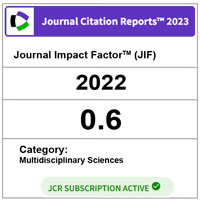Preparation and characterization of polysulfone membrane coated with poly(ether block amid) for oxygen enrichment process
DOI:
https://doi.org/10.11113/mjfas.v15n2019.1226Keywords:
Polysulfone, PEBAX, Oxygen, Nitrogen, Gas SeparationAbstract
Oxygen enriched air (OEA) is widely applied in various areas such as chemical and medical applications. Currently, cryogenic distillation and pressure swing adsorption are the two common technologies that being commercially used for i the production of OEA. However, these two techniques are not economically favorable due to required intensive energy and large built-up area. With the advancement of membrane technology in separation process, it garners the interest from both industrial and academic to explore the feasibility of membrane in gas separation. In this study, polysulfone (PSF) hollow fiber membranes with poly(ether block amide) (PEBAX) coating were used for the separation of O2/N2 gas. The hollow fiber membranes used in this work were fabricated by phase inversion spinning process using PSF pellet, along with N,N-dimetyhlacetamide (DMAc) and ethanol (EtOH) as solvent and co-solvent, whereas tetrahydrofuran (THF) as additive. The fabricated membrane exhibited dense structure in the inner layer whereas finger like layer at the outer surface. The formation of this structure was attributed by rapid phase inversion of the solution arose from strong solvent used. The EDX surface mapping analysis confirmed the formation of PEBAX coating on the membrane surface. Gas permeation study in this work illustrated that the pristine PSF membrane exhibited better gas separation performance relative to the PEBAX coated membrane with 20% higher in terms of permeance. The results obtained from this work suggested that the PEBAX coating enhanced the membrane surface but not certain to improve the gas separation performance. Further study on the PEBAX materials for the membrane coating is essential to polish its potential in gas separation.
References
Ahmadpour E., Shamsabadi A. A., Behbahani R. M., Aghajani M., Kargari A. (2014). Study of CO2 separation with PVC/Pebax composite membrane. Journal of Natural Gas Science and Engineering, 21, pp.518-523.
Anderson, M., Wang, H., Lin, Y. (2012). Inorganic membranes for carbon dioxide and nitrogen separation. Reviews in Chemical Engineering, 28(2-3), pp.101-121.
Belaissaoui, B., Le Moullec, Y., Hagi, H., Favre, E. (2014). Energy efficiency of oxygen enriched air production technologies: Cryogenyvs membranes. Separation and Purification Technology, 125, pp.142-150.
Bernardo, P., Clarizia, G. (2013). 30 years of membrane technology for gas separation. Chemical Engineering Transactions, 32, pp.1999-2004.
Chong, K. C. , Lai, S. O., Lau, W. J., Thiam, H. S., Ismail, A., Zulhairun, A. (2017). Fabrication and characterization of polysulfone membranes coated with polydimethysiloxane for oxygen enrichment. Aerosol and Air Quality Research, pp. 1 – 8.
Chong, K. C., Lai, S. O., Thiam, H. S., Teoh, H. C., Heng S. L. (2016). Recent progress of oxygen/nitrogen separation using membrane technology. Journal of Engineering Science and Technology, 11(7), pp. 1016-1030.
Kim, S., Lee, Y. (2013). High performance polymer membranes for CO2 separation. Current Opinion in Chemical Engineering, 2(2), pp.238-244.
Peng, N., Widjojo, N., Sukitpaneenit, P., Teoh, M., Lipscomb, G., Chung, T., Lai, J. (2012). Evolution of polymeric hollow fibers as sustainable technologies: Past, present, and future. Progress in Polymer Science, 37, pp.1401-1424.
Powell, C., Qiao, G. (2006). Polymeric CO2/N2 gas separation membranes for the capture of carbon dioxide from power plant flue gases. Journal of Membrane Science, 279(1-2), pp.1-49.
Ren, X., Ren, J., Deng, M., (2012). Poly(amide-12-b-ethylene oxide)/polyethylene glycol blend membranes for carbon dioxide separation. Separation and Purification Technology, 89, pp.1-8.
Smith, A., Klosek, J. (2001). A review of air separation technologies and their integration with energy conversion processes. Fuel Processing Technology, 70(2), pp.115-134.
Wang, L., Li, Y., Li, S., Ji, P., Jiang, C., (2014). Preparation of composite poly(ether block amide) membrane for CO2 capture. Journal of Energy Chemistry, 6, pp.717-725.
Wu, L. S., Sun, J. F., Wang, Q. R. (2006). Poly(vinylidene fluoride)/polyethersulfone blend blend membranes: Effects of solvent sort, polyethersulfone and polyvinylpyrrolidone concentration on their properties and morphology. Journal of Membrane Science, 285, pp.290–298.







